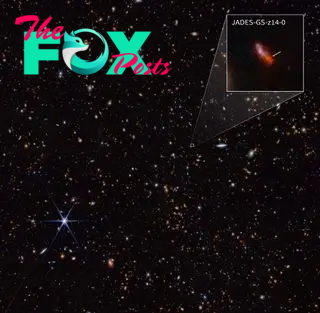Science
James Webb telescope discovers the 2 earliest galaxies in the known universe — and 1 is shockingly big
The James Webb Space Telescope (JWST) has done it again.
According to new research, astronomers using the powerful infrared telescope have revealed what appears to be the two earliest, most distant galaxies in the known universe, dating to just 300 million years after the Big Bang.
The ancient galaxy duo break the records set by another pair of galaxies discovered by JWST last year, which date to roughly 330 million years after the birth of the universe — pushing back our understanding of cosmic dawn even further.
Besides being exceptionally old, the newly discovered galaxies — named JADES-GS-z14-0 and JADES-GS-z14-1 — are also unusually large for such an early time in cosmic history, according to the discovery paper published May 28 to the preprint server arXiv. With the larger of the galaxies measuring an estimated 1,600 light-years across, the discovery adds to a mounting pile of evidence that the earliest galaxies in the universe grew up much faster than leading theories of cosmology predict to be possible.
"It is stunning that the Universe can make such a galaxy in only 300 million years," lead study author Stefano Carniani, an assistant professor at the Scuola Normale Superiore in Pisa, said in a statement.
Related: James Webb telescope sees 'birth' of 3 of the universe's earliest galaxies in world-1st observations

The researchers spotted the ancient duo in a region of space known as the Hubble Ultra Deep Field. Earlier observations of the area with the Hubble Space Telescope revealed galaxies from the first 800 million years of the universe — but the light from even earlier galaxies, which had shifted into infrared wavelengths while Travelling across the expanding universe, required JWST's powerful infrared instruments to detect. The team examined the region for five full days using JWST's Near-Infrared Camera to achieve the results.
-

 Science2d ago
Science2d agoInside Capitol Hill’s Latest UFO Hearings
-

 Science2d ago
Science2d agoYou Won’t Want to Miss the Leonid Meteor Shower. Here’s How and When You Can See It
-

 Science3d ago
Science3d agoHere’s What Trump’s Win Means for NASA
-

 Science6d ago
Science6d agoWhy Risky Wildfire Zones Have Been Increasing Around the World
-

 Science6d ago
Science6d agoIt’s Time to Redefine What a Megafire Is in the Climate Change Era
-

 Science1w ago
Science1w ago4 Astronauts Return to Earth After Being Delayed by Boeing’s Capsule Trouble and Hurricane Milton
-

 Science1w ago
Science1w agoThe Elegance and Awkwardness of NASA’s New Moon Suit, Designed by Axiom and Prada
-

 Science1w ago
Science1w agoSpaceX Launches Its Mega Starship Rocket. This Time, Mechanical Arms Catch It at Landing



























